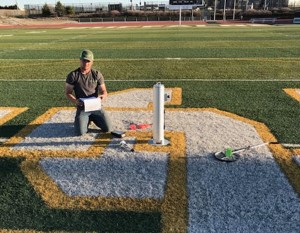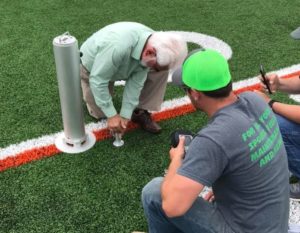Regulating infill levels and g-ratings is crucial for knowing the risk of injuries, and lifespan of the fields surface. To determine these factors, having proper tests performed is paramount.
Why Test Your Fields?
Lowering the risk of injury on any artificial surface starts by knowing what condition the field is in. In accordance to test method F355, an impact missile dropped at 24 inches shall be tested at each specific test point three times and the average of the second and third drop shall be recorded. The g-value rating is then logged. If the g-rating is equal to or greater than 200 g’s, the synthetic playing surface must be brought back to passable values.

Steps To Maintain G-Max Rating
Infill levels impact a test greatly. Having low infill in a field will cause g-ratings to spike and risk of injury to greatly increase. Adding infill to areas in the field that may be low is the first step in lowering risk. Next is running the decompaction device over the surface to pull compacted rubber that has settled in a field back to the surface, loosening the area.

Maintaining Your G-Max Rating
Regular testing helps to get a sense of the actual field surface conditions and allows you to get ahead of any emerging issues. Our main goal at Fix A Field LLC is to find issues before they become greater problems and therefore reducing the risks of injuries. Deep field grooming stands the fibers back up and maintains a debris free area.
